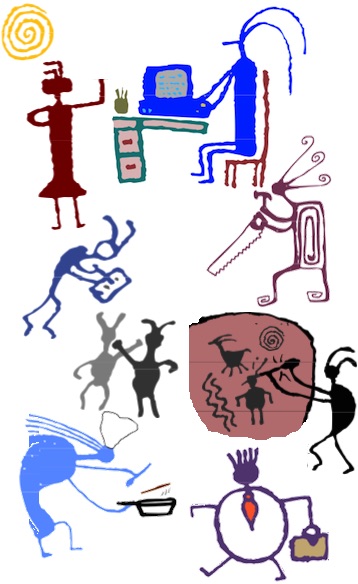All around the world, particularly in the USA, online volunteers, most working on their own, independent of any formal group, have been trying to put together SIV, P-1 and P-2 visa applications for Afghans who helped the USA military, USA programs and USA citizens working in Afghanistan. SIV folks worked with USA Armed Forces as translators or interpreters in Iraq or Afghanistan. The P-2 visa is for Afghans who helped in USAID-funded projects, participated in US State Department programs, or helped women start businesses, access education and health care and promote women’s rights – all things that will make them the target of the Taliban.
For 20 years, these Afghans completely embraced ideas that the Taliban finds abhorrent: women in most workplaces and professions, a free, questioning press, sports for everyone, music, art, movies, social media, travel abroad, and a vibrant, active civil society. Western reporters interviewed these Afghans, profiled them in heart-warming stories on TV and in online news sites, with quotes and photos. I worked alongside some of these Afghans in 2007, mostly in Kabul, but also briefly in the Pansjir Valley and Kandahar. I took photos with them, I blogged about them, and after I left the country, we stayed in touch, I edited press releases and reports they wrote in their jobs, we met up when they visited the USA.
And now, that work, those travels, those photos, those public pats on the back over two decades, may get them killed. That cherished certificate of recognition from the US State Department or some other foreign government has suddenly become a potential death sentence.
This effort, which is largely taking place on WhatsApp and Signal, has been called a “digital Dunkirk.” – The Atlantic, “Escape From Afghanistan,” August 23, 2021.
For the last two weeks of August and most of September, I’ve been part of this global virtual volunteering endeavor, this “digital Dunkirk.” And we’ve largely been a failure.
We’ve stay up late with and gotten up early for our desperate, terrified Afghan colleagues, messaging back and forth in those hours when the time difference has us all up at the same time, giving them updates on what we’ve found out and what we’ve done, reading their updates about what they are seeing, debunking rumors they’ve heard (and there are SO MANY rumors), offering sympathy and encouragement while trying to not sound glib or shallow. We’ve spent hours and hours on visa applications, reading the guidelines over and over, making sure that absolutely every bit of essential info the State Department might want is there, exercising the bits they don’t but that Afghans feel so proud of, like a declaration of honorary citizenship for some US city they visited. Part of the trouble with helping many Afghans stems from having trouble getting contact info for former employers that they worked for five to 10 or 15 years ago – work that could still get them killed now, under the Taliban. For Afghans we didn’t work with directly, we research former employers, track down the names of staff, write them, beg them. We continue to track down US staff who used to work at the Afghanistan embassy, people who have carefully hidden their email addresses because they are, no doubt, overwhelmed with strangers emailing them – including buying a subscription to LinkedIn just so we can message these people – and we ask, could you sign off on this P2 application I prepared for so-and-so? Only you can do it, because I didn’t work with him. It has to be you. Won’t you please? We’ve written our US Representatives and US Senators, telling them what we’re doing, asking if they can look into the matter for this person, specifically. We wonder just how far we can stretch the definition of de facto family in an application, to include nieces, nephews, adult brothers, in-laws… We look at the revised visa requirements for other countries and do the best we can in putting together applications for them, too.
We write, and research, and re-write, and research, and answer texts all morning and all night. We sometimes believe that if we slept, if we stepped away from our phones, we might miss an opportunity to help someone escape the country. We also scrub our social media accounts and web sites and blogs of photos and identifying info for all the Afghans we’ve worked with, both back in Afghanistan and right here in the USA.
The last two weeks of the US at the Kabul airport were horrific. One Afghan colleague never got her US paperwork – she still hasn’t, despite my US Senator’s staff assuring me that they had looked into the matter and it’s “in process” – but she did get visas for herself and her whole family for Australia. They rapidly packed and drove to the airport. They never got close to the gate – they never even got out of the car. It was a terrifying experience, and when they finally realized the Taliban would not let them through, even by foot, they returned home, defeated, despondent. A few hours later, the bomb went off. They were safe, for the moment – but we knew they weren’t getting out any time soon. It was like hearing a massive door slam shut.
The vast majority of the people that the Digital Dunkirk volunteers have tried to help have not gotten out of Afghanistan. Those people, those US and Australian and UK and French and German allies, are hiding at home, wondering when they will run out of money for Internet access, when they will run out of food, when a landlord will turn on them for not paying rent, and when a neighbor will turn them in, knowing they could win favor with the Taliban for doing so.
And we tremble when a social media account of an Afghan colleague goes silent.
When people say volunteering feeds the soul, that it lifts you up, that it’s oh-so-healthy, they are leaving out the volunteering, onsite or online, that is soul-draining, that it can leave you feeling helpless and distraught despite pouring so much into it. I’ve always bristled when people say, “Virtual volunteering is great for people who don’t have a lot of time to volunteer” or “virtual volunteering is impersonal!” Neither statement is true – not of any virtual volunteering I’ve ever researched, and especially not for the virtual volunteering I’ve most recently been a part of.
Per my virtual volunteering experience in this Digital Dunkirk: I’m exhausted. I’m frustrated. I’m angry. And I’m out of tears some days. And if you tell me the value of this volunteering in terms of the number of hours I contributed and the dollar value of those hours, I will probably want to hit you in the face as hard as I possibly can. I won’t, because I am committed to non-violence, but I’ll want to.
I’m not alone in this virtual volunteering – I’m in contact with folks at an NGO that are trying to get more than a dozen families out, and it’s been wonderful to share information, advice and frustrations. There’s also:
- Task Force Pineapple, a high-profile effort by US military personnel and others that successfully evacuated more than 1000 Afghan allies and their families.
- More than 40 volunteers at the University of Pittsburgh‘s Center for Governance and Markets are (were?) helping too. And then there are people like me, alone, trying to help Afghans they worked with: I see the posts all over Twitter and my LinkedIn account by people asking for advice, reporting their own progress, linking to some resource they’ve found.
- There’s Special Operations Association of America (SOAA) is comprised of USA volunteers that says it is working side-by-side with the US government “to bring home our wartime brothers and sisters. Our mission is to safely provide humanitarian support in direct support of US policy.”
- In this incredible 50 minute podcast, “Roamings and Reflections,” humanitarian assistance and international development expert Sasha Ghosh-Siminoff joins host Nicholas Heras to recount the massive effort to evacuate Afghans as the Taliban seized Kabul. It really captures what those days in Afghanistan were like for the online volunteers in the USA and elsewhere trying desperately to get people on those last flights. Many US government workers were risking their jobs by helping volunteers trying to get Afghans out of the country on those last flights. At one point, Ghosh-Siminoff says that, rather than digital Dunkirk, the effort, “was more of a digital Schindler’s List.”
- This Stars and Stripes story, Afghan evacuation took hidden toll on mental health of volunteers who tried to help, notes that many of the volunteers in Digital Dunkirk efforts are military veterans who served in Afghanistan Veterans who had unresolved trauma from their time at war and thought helping to evacuate people would “make things right,” according to Amy Williams, the chief clinical officer at Headstrong. The story notes that members of an online support group for such volunteers said they didn’t think they could complain about their stress when Afghans have far worse situations, or they they didn’t think others would understand what they had gone through. Some volunteers, though, said they did not feel any adverse effects from their unsuccessful efforts to help Afghans. On the contrary, they said they feel better for having tried.
- Here is Stars and Stripes profile of several Digital Dunkirk efforts.
Of course, the stress and frustration of online volunteers in this effort is nothing compared to the Afghans we’re trying to help. In addition to being terrified of the knock at the door that means the Taliban is there, to search the home, to take away boys and young men to fight, to take away girls for rape (there’s no such thing as “child marriage” – please stop saying that), to find files and data that could prove someone in the family worked with the USA, the UK, Australia, or some European country, Afghans are also running out of money and food.
All this volunteering may be for naught. The visa applications may never come through, and even if they do, these many thousands of Afghans may never get out of the country. Many may be murdered. The women, in particular, will suffer horribly.
For the online volunteers trying to help, no certificate, no statistic on the monetary value of the time they contributed, no t-shirt, is going to serve as appropriate recognition for what they’ve done. There’s just one way we’re going to feel good about our virtual volunteering: getting people out of Afghanistan.
It’s been so worthwhile to connect with other volunteers, sharing resources and feeding off of each other to maintain hope. And a shoutout to the friend that isn’t involved in any of this, but listens to me rant and gives me words of encouragement – she’s helping to, as an online volunteer, even if she doesn’t know it. Thank you to everyone out there that’s volunteering online to help Afghanistan, whether it’s to help people get out, pressure their own governments to, in turn, pressure the Taliban to keep their promises (which they mostly have NOT so far, in case you aren’t paying attention), or to help Afghan refugees in their own country. I see you. I value you. Others do too. Keeping doing what you can.
Also, don’t you dare tell me that virtual volunteering is impersonal.
I have an Afghanistan Twitter list that I use to stay abreast of what’s happening in the country – it’s public – you can use it too. I’ve put together this list of ways Afghans can keep their computers and phones safe, and I’ve put together this list of online resources for Afghans trying to teach girls at home (frustrating, as most Afghans don’t have Internet access, most Afghans don’t read English, and all these are in English – there really needs to be a site in Dari and Pashto, but I can’t find such). You can feel free to share these resources with anyone you think could benefit from such, and your suggestions for additions to these resources would be helpful.
A sad turn of events has many of us feeling especially pessimistic: the State Department sent an email on September 9th to at least some Afghans who had applied for the P-1 visa, that said, in part:
Please note that case processing cannot begin until/unless you relocate to an eligible processing country. Processing is not feasible in Afghanistan, Iran, North Korea, Syria, Turkey, and Yemen. Once you have relocated to a country where refugee processing can occur, you will need to inform the U.S. Department of State Bureau of Population, Refugees, and Migration… of your current location and contact information for your referral to be assigned to a U.S.-funded overseas Resettlement Support Center for case processing… The United States is unable to provide protection or support to you while you await a decision on your refugee case. Case processing can be lengthy (potentially 12-14 months), so please be aware that this process could require living in and supporting yourself and your family in a third country for a substantial amount of time until case processing is complete. Even if you qualify for the P-1 or P-2 program and travel outside of Afghanistan, there is no guarantee that you will be approved for resettlement to the United States.
The information has been a gut punch to the Afghans I’m working with. Do I tell them now to get out of Afghanistan, anyway they can, even illegally, and once in that country, follow what the US State Department has said? What do I say now? I have no idea. And neither do all the other online volunteers I work with.
But Digital Dunkirk continues.
If you are helping people who are still in Afghanistan and are trying to get out, I have a Google Shared drive where I am sharing all of the information and links I have found helpful. If you see something in the drive that is inaccurate or outdated, or you have resources that I could add to such, please email me at jcravens42 “at” yahoo.com, putting “helping Afghans” in the subject line.
And in case you are wondering: I am working to support five Afghans and their families to leave the country.
- Two are women I worked with when I was there in 2007. Their P-1 and P-2 applications, which I submitted since I worked directly with them in work that was funded in part by USAID, have been flagged by one of my US Senators, Senator Jeff Merkley of Oregon. One women needs to get out by herself, but another needs to get her sister, her mother and four nieces out. Next steps? Finding a way for them to get to another country to live for 12 – 18 months (see earlier US State Department communications).
- One is a man, who did some work for the US Embassy. I have the names of the US Embassy staff who signed off on his payment paperwork. Only they can submit his paperwork. And they won’t reply to my emails. I now need to find someone who worked at the US Embassy who will be willing to submit his P-2 paperwork.
- One got out of the country with his immediate family and is now, supposedly, in process for his P-2 – and since this is being handled by a US-based nonprofit I did not work with, there’s not much I can do other than share hopeful info.
- One is someone who was a part of a USA-based nonprofit that I have volunteered with – that nonprofit has submitted his application for a P-2 application, but he’s stuck in Afghanistan, like my two colleagues. One staff member at the nonprofit was trying to communicate with 14 people that was associated with this nonprofit, and it just became way too much, so she’s creating teams of volunteers to be the primary contact for each of the 14 people. I’m on a team for a man who is a journalist. Next steps? Finding a way for him and his family to get to another country to live for 12 – 18 months (see earlier US State Department communications) and any associations of journalists abroad who might care about his situation and want to help in some way.
If you can help with any of the aforementioned four situations, contact me.
Update: One of the people I have been helping made it to Pakistan with her four nieces and mother, and then was able to go on to Australia, because she attended university there many years ago and that network has been working to get alumni out. Her sister was unable to go too – she could not get a visa for her. I continue to try to help her sister and others.
Update: Another perspective on being a part of the online #DigitalDunkirk, to get our endangered allies, the people we put into this precarious position, out of Afghanistan. This is not the warm and fuzzy just-show-up-when-you-feel-like virtual volunteering story you will find elsewhere. The emotional toll is real.
Update: One of the people I was trying to help got out, no thanks to me nor the USA. She’s now in Australia with her nieces and mother, and she wrote this account of why she fled and what her final weeks in Kabul were like. Her sister, her brother and her brother’s family remains. One of my co-workers also remains there. The USA is their only hope – and the USA offers no help to get them out.






